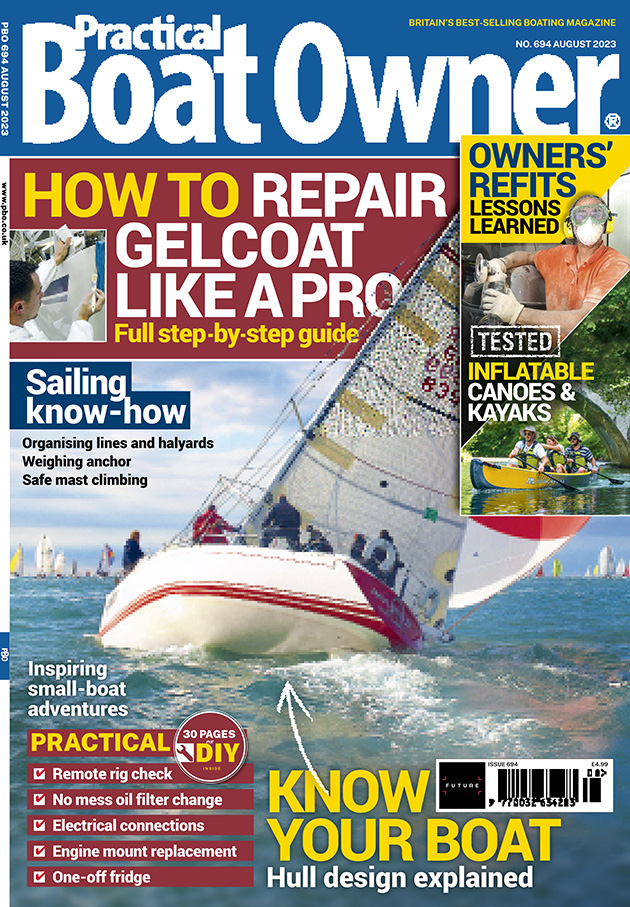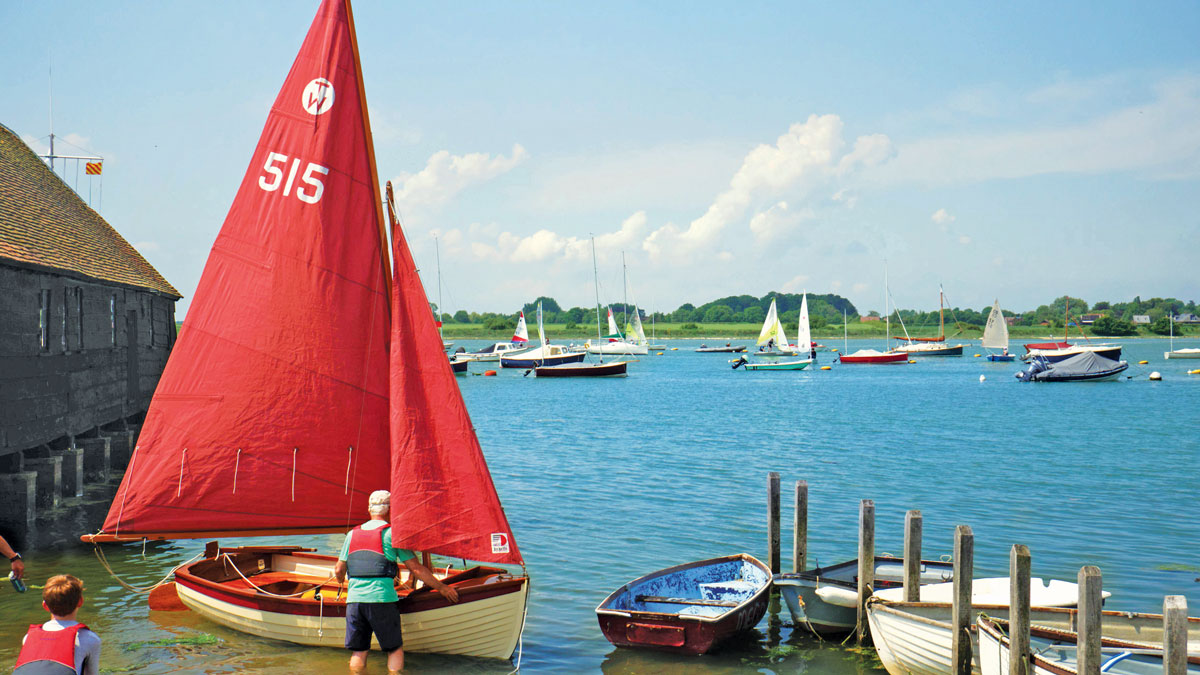The trailerable Tideway 10 has the benefits of her sister vessel, the Tideway 12, but is lighter and easier to launch and recover by hand
Fond as I was of my Tideway 12, I let her go while looking for something lighter and easier to launch and recover by hand on steep slipways or through shingle.
Sometimes it’s not possible to use the car as a towing aid.
A lighter Tideway 10 could be the answer and so on a cold rainy day in early January my wife, Brenda, and I set off to drive 120 miles north to the Royal Harwich Yacht Club and collect the Tideway 10 that I’d bought after seeing an online advertisement.
I talked with her owner and decided to pay in advance from the information gathered.
One of the things to be prepared for when collecting a trailer boat is the condition of the road base wheel bearings.
You really do need to take replacement bearings and hubs with you and be prepared to change them before towing away.

The Tideway 10 is 10ft 2in long
It’s only through inspection that you can be sure they won’t let you down on the motorway.
I’m a non-mechanical sort of chap but was shown how to do this by a mate.
If you intend to trailersail it’s worthwhile learning how to do the job and then you’ll have no worries.
It’s a simple 10 minute job to change the traditional tapered type bearings.
For the sealed-for-life type of bearings you will need a mechanic with a workshop to change them, but even I can inspect and change conventional tapered bearings on the road side and this is why I like them for marine use.
On inspection, I was happy the existing bearings were fine so Brenda and I set off towards the South Coast in very heavy rain.
I was towing without a boat cover and when I stopped at a layby the boat had enough water on board for a bath – I’d forgotten to remove the drain plug.
Boat out plug out, boat in plug in. Should be easy to remember.
Line shrinkage
Safely back on the lawn at home I set about rigging the boat and getting used, once again, to the maypole with throat and peak halyards, double topping lift, jib halyard, forestay, shrouds, kicker, jib sheets, mainsheet and the rest.
This is a lot of rope for a small boat and it’s too easy for me to get in a right old muddle.
Compared with my simple standing or balanced lug sail boats, rigging the gunter Tideway 10 takes a while.
I simply couldn’t get the main to set well so my mate came and had a look.

By contrast, the simplicity of my little lugger
He immediately spotted the problem. The luff rope had shrunk! Who’d have thought?
So he set about some serious surgery, opened up the luff of the sail, cut the rope with a heat knife and inserted/welded/stitched another length of rope.
Then we pulled the crinkled luff sail flat over the extended rope and the result was a reasonable sail.
Luff rope shrinkage is apparently a common problem and many people buy a new sail when they don’t need to!
First launch of the Tideway 10
I decided not to bother with a launching trolley and to launch directly from the road trailer.
Getting a launching trolley onto a road trailer is not always as easy as you think it will be. I also decided not to bother with a winch owing to the lightness of the boat.
I did add a jockey wheel and lowered the height of the trailer bunks to make it easier to recover the boat.
I used an angle grinder to reduce the length of the bunk supports to give ground clearance.
Having done this I was able to launch and recover by hand without the need to get the bearings wet.
Continues below…
Tideway 12: seaworthy and stable
Prolific boat owner Clive Marsh extols the virtues of the Tideway 12, which can be launched by hand from a
Orkney Longliner & Sussex beach boat
Clive Marsh sails from Rye Bay upriver to Bodiam Castle in East Sussex by Orkney Longliner and Sussex beach boat
What is a lugger? And why they make great trailer-sailers – answered!
Compulsive boat owner Clive Marsh explains why little luggers make perfect trailer-sailers
Normandy Flobart & Sussex beach boats
Prolific boat owner Clive Marsh sings the praises of Sussex beach boats and their French sisters, the Normandy Flobarts
On recovery, I removed everything from the boat so as to reduce weight and found it easy to pull her up to the bow snubber by hand.
The first launch was intended to find out what needed to be done to get her sailing really well.
It was a rarely bright day in February and sailing in company we started out in winds that were less than Force 1.
She ghosted along well when suddenly, out of the blue, the wind increased to a good Force 4.
She creamed along very well and, with no reef, my modest weight was adequate ballast.
The Tideway 10 is a very stable boat. I did allow her gunwale to close within one inch of the water and she was steady and solid.
I could also stand and move around and she was stable and reassuring.
Minor snags
There are things that need attention. The jib sheets and mainsheet find things to get caught on. This is easily sorted.
I need to get a better shape and height to the sail. This is work in progress. But overall there is nothing wrong with the little boat, she just needs tuning here and there.
Fitting an outboard when rigged for sailing could be interesting, but, for me, this is a sail and oar boat.
I never used an outboard on my Tideway 12 and this little Tideway 10 feels the same.
My Tideway 10 is gunter rigged so how does she compare with the lug rigged version? My direct lugger comparison is with my Smack’s Boat and my Emsworth Lugger.
Both of these boats can be rigged and on the water in a few minutes.
By comparison, rigging the gunter takes ages.
So is it worth it? Lugger comparison Well, there have been times when sailing towards Hayling Island against wind and tide in little luggers that I couldn’t make progress, when the Bermudian and gunter rigged boats sailing with me could.

Slow progress in the calm only seconds before a Force 4 – who’d have thought it?
So, in these circumstances the lugger struggled while the gunter prevailed.
The double topping lift on the gunter rig was also useful for capturing the sail/yard and raising the boom so that I could row unencumbered.
However, with so much rope it was more than likely that I (in particular) could get into that right old muddle when things went wrong in strong winds.
But the lugger is easier to de-power down wind and for a small single handed boat feels safer to me.
So what do I prefer? Lugger or gunter?
Well, after more than 50 years of messing about in boats I can’t decide and this is the reason why I keep both.
Could the gunter rigged Tideway 10 be the perfect boat?
Yes, at this point in time and until my needs change she certainly is. Or should I try the Tideway 10 lugger?
Tideway 10 specifications
Model: Tideway 10
Length: 10ft 2in (3.10m)
Beam: 4ft 10in (1.48m)
Sail area: 49ft2 (4.55m2) single lugsail or 58ft2 (5.38m2) gunter mainsail and jib
Draught: 5ft plate up/2ft 3in plate down
Weight: 165lb (75kg) with lugsail 198lb (90kg) with gunter rig (NB: These are for the GRP boat, wooden boats will vary)
Enjoyed reading Tideway 10: Gunter or Lugger? 
A subscription to Practical Boat Owner magazine costs around 40% less than the cover price.
Print and digital editions are available through Magazines Direct – where you can also find the latest deals.
PBO is packed with information to help you get the most from boat ownership – whether sail or power.
-
-
-
- Take your DIY skills to the next level with trusted advice on boat maintenance and repairs
- Impartial in-depth gear reviews
- Practical cruising tips for making the most of your time afloat
-
-








